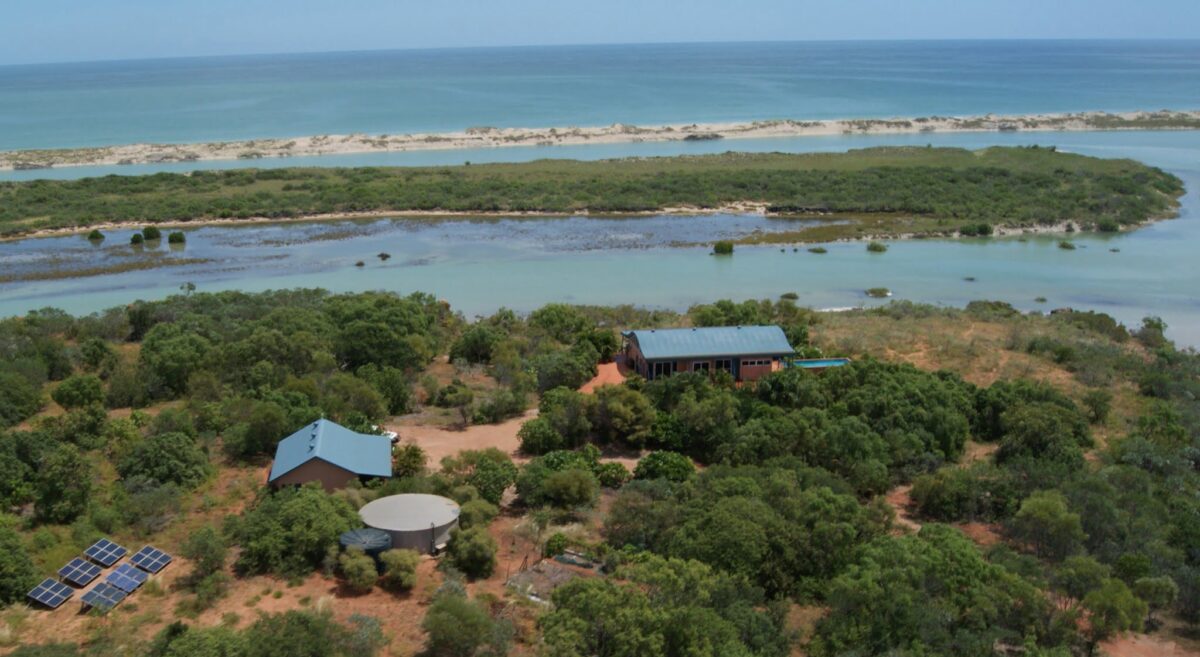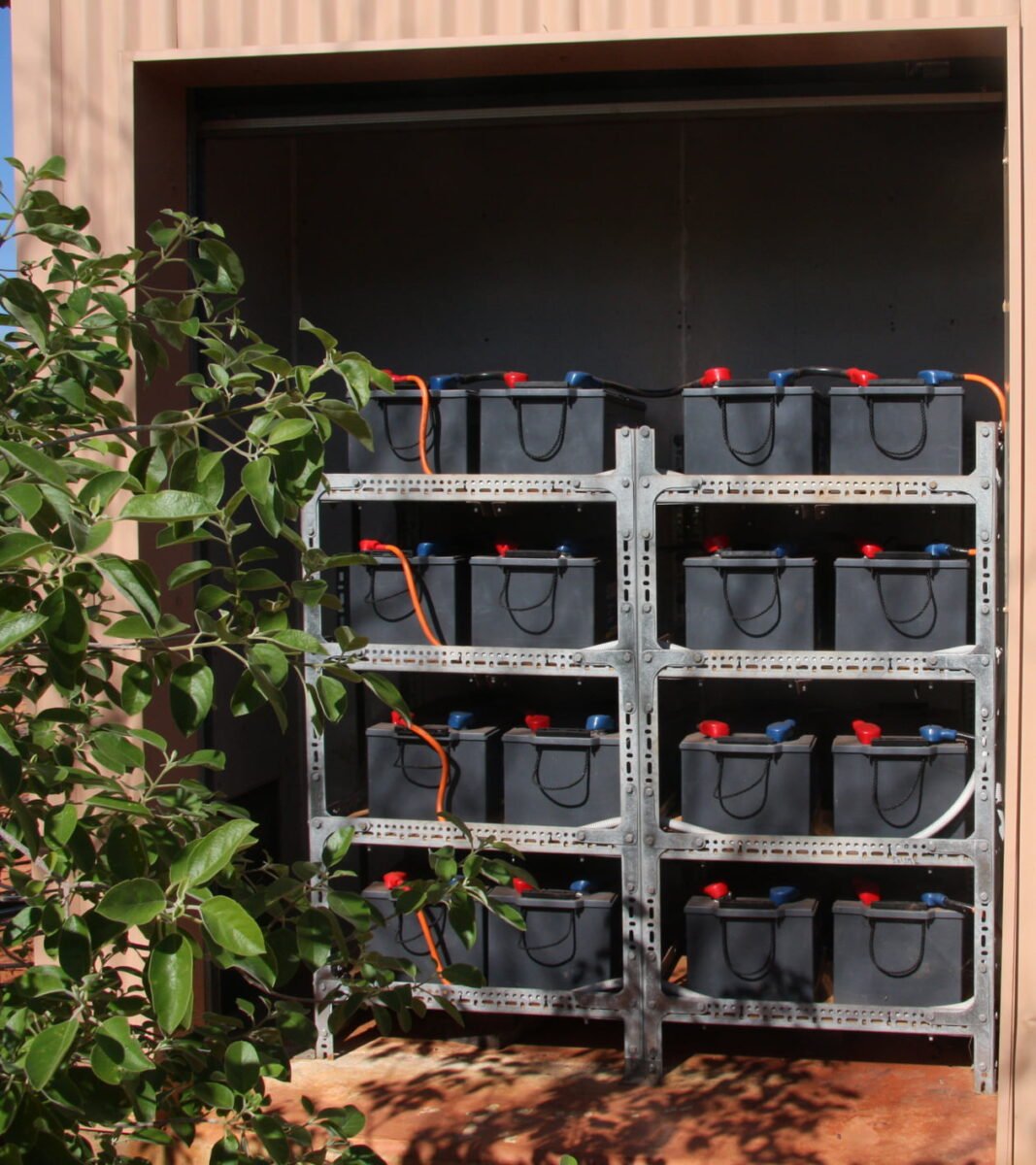Best Batteries for Stand-Alone Solar
Knowing the best batteries for solar power storage saves huge sums. This rvbooks.com.au guide explains how and why. It’s all to do with having enough energy and having enough power. Energy and power, however, are different concepts. For stand-alone solar it is mostly energy, not power, that matters.
 Author’s previously-owned bank of sixteen Exide 12 volt gel cell batteries. Each is of 235 amp hour – about 45 kWh total. They are connected in series-parallel to provide 48 volts. Pic: rvbooks.com.au
Author’s previously-owned bank of sixteen Exide 12 volt gel cell batteries. Each is of 235 amp hour – about 45 kWh total. They are connected in series-parallel to provide 48 volts. Pic: rvbooks.com.au
Knowing the best batteries for solar power storage saves money. This rvbooks.com.au guide explains how and why. It’s all to do with having enough energy and having enough power. Energy and power, however, are different concepts. For stand-alone domestic solar it is almost entirely energy, not power, that matters.
Energy and power explained
Energy enables work to be done.
Power relates to how fast energy is used. Starting a car engine needs high power but the energy used is tiny! It’s less than that needed to run a five watt LED light globe for an hour. It depletes the battery by about 2%. Another example is lifting 100 (1 kg) cans onto a shelf. A 10-year-old does this with ease. But were that 100 kg to be in one lump, hoisting it to that same shelf needs identical energy, but massively more power. Confusingly, however, even energy suppliers speak of grid-power!
A battery’s stored energy measure is amp hours. An ideal 100 amp hour battery supplies one amp for 100 hours, ten amps for 10 hours or one hundred amps for 1 hour. It has both energy and power.
Knowing this difference ensures you buy only the batteries you need. Costly ones such as a 500 amp hour bank of lithium-ion (e.g. LiFePO4) batteries can deliver far more power than a domestic home will ever need, but only marginally more energy than a two-thirds cheaper bank of AGM batteries. Unless you truly need that LifePO4’s power, buying them like buying an overhead crane to stack 1 kg soup cans. spacer height=”20px”]
Lead acid batteries
Lead acid batteries are totally known, relatively cheap, simple and affordable. They store ample energy but have limited power. Countless stand-alone solar systems use them because that power is more than ample anyway! They are bulky and heavy, but that too is rarely a problem. To ensure long life, use them in stand-alone systems(routinely) only from 100% to 70% of full charge. Unless essential, do not discharge them below 50%.
AGM (Absorbed Glass Matt) batteries
AGM batteries too are bulky and heavy but hold their charge for a year or more. That ability is valued in standby systems that are left unattended for long periods. Virtually unused ones are often sold at very low prices.
Lithium-ion
Vendors promote lithium-ion batteries as having ‘far more power’. The claim is true, but that power ONLY needed if you intend to do extensive arc welding etc. But for that, you need a great deal of energy as well. Here, a diesel generator makes more sense. No normal loads in a typical home or property stand-alone system need anything like even a small lithium-ion battery’s power.
The main benefit of lithium-ion batteries is they are about one third the size and weight of lead acid and AGM batteries – but that rarely matters for most homes and properties. One benefit, however, is that more of their capacity can be used without overly shortening their life.
Conventional sealed lead acid, gel cell and AGM (Absorbed Glass Matt) battery banks are cheaper and simpler to install. They are also far more readily available. The one-time popular gel-cell batteries are still made but now only rarely used as they have no major advantage over lead acid or AGM.
Capacity required
Solar capacity has fallen in price, by over 80% since 2010. Battery capacity has risen by a now 80%. If space is available, it pays now to maximise solar capacity – even if cannot be optimally located (i.e. facing the sun at midday). Doing so will provide you with output except even on totally overcast days. Doing so enable you to reduce the now costly battery capacity – that will then be fully charged on most days.
People living on solar tend to use less energy than those on grid power. An energy-efficient (off-grid) three-bedroom solar home averages 10-12 kWh/day. If you optimise your home for energy efficiency you will use far less energy. Our book Solar Success explains how to do this at next to no cost.
Advisable battery capacity also depends on your use of generator back-up. Zero reliance on generators is possible, but the solar and battery capacity needed is huge. Except where there is less than two PSH/day at times (see * below) using solar and battery capacity for about 90% of the time is more cost-effective. Designing for 95% doubles system price – and still seven days a year without battery energy.
Here’s an example. Assuming a draw of 12 kWh/day (of which the overnight draw is 4.8 kWh), depleting the battery by 10% requires about 48 kWh battery capacity. This also provides for two full day and nights with zero input that depletes the batteries by 50%. This is readily affordable with AGM batteries (see * below) but would cost close to A$50,000 with lithium-ion).
Best batteries for solar power storage – cost involved
Lithium-ion batteries can be routinely discharged to about 20%. This enables a smaller capacity bank but if only 24 kWh, the cost, however, is in 2019) around A$25,000. They are typically guaranteed for eight years, but likely to last longer – albeit with reduced available capacity. Lithium-ion is promoted as superior in many ways but of little benefit for stand-alone systems. Traditional batteries are still seriously worth considering. They are cheaper, readily obtainable and much simpler to understand, install and maintain.
Lead acid batteries are excellent for storing energy
Lead acid batteries are still excellent for storing energy. A 48-volt lead acid, gel cell or AGM bank of 45 kWh is ample for three-bedroom homes. Given an adequate inverter, this enables several major domestic appliances (or power tools) to be used at once. They prefer 5 to 25 degrees Centigrade. If typically discharged by 20% they typically last 10-14 years. If discharged less, they may last even longer. Some still work (if not that well) when 20 years old.
 The author’s self-designed and built solar system powers his self-built home north of Broome (north-west Australia.) The Indian ocean is in the background. Pic: rvbooks.com.au
The author’s self-designed and built solar system powers his self-built home north of Broome (north-west Australia.) The Indian ocean is in the background. Pic: rvbooks.com.au
* Peak Sun Hours
A Peak Sun Hour (PSH) is a solar industry term. It’s a bit like measuring rain falling into a glass e.g. 1 PSH is the amount of sunlight (if of 1000 watts per flat) per square metre for one hour. Were that to be 500 watts for two hours, that too is thus 1 PSH. Solar for home and property systems is feasible where the yearly average exceeds 2 PSH. To establish your PSH: Google your locality plus Peak Sun Hour.
Solar reality
Marketing and promotion often confuse stand-alone system reality. Solar Books is free of this. Apart from selling our own books, this website has no financial involvement in the industry. The author’s background is electrical and mechanical engineering and technical writing. Our articles and books assist countless others to do the same.
Further information
- Unlike most lead-acid based batteries, AGM batteries do not degrade if unused over time. Many company automatic power back-up systems replace often totally unused AGM battery banks (typically for 10% of their new price. They are often advertised on eBay, but beware of freight cost (if12 volt they are typically 33 kg per 100 amp hour).
- See also https://rvbooks.com.au/are-lithium-ion-batteries-worth-their-price/
Solar Success has all you need to know to design and install your home or property system. Tens of thousands use it worldwide. It is totally revised between prints runs. Now, (2019) it is in its Third Edition. The (4th edition) Solar That Really Works! does likewise for cabins and RVs. My other books are Caravan & Motorhome Electrics, and the Caravan & Motorhome Book. All are technically sound and written in plain down to earth English. For more about the author please click on Bio.

 Author’s previously-owned bank of sixteen Exide 12 volt gel cell batteries. Each is of 235 amp hour – about 45 kWh total. They are connected in series-parallel to provide 48 volts. Pic: rvbooks.com.au
Author’s previously-owned bank of sixteen Exide 12 volt gel cell batteries. Each is of 235 amp hour – about 45 kWh total. They are connected in series-parallel to provide 48 volts. Pic: rvbooks.com.au


